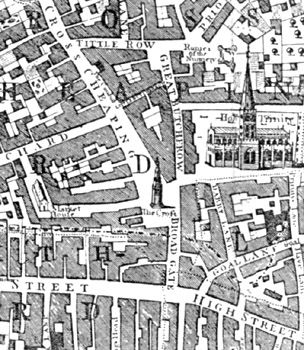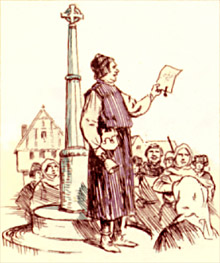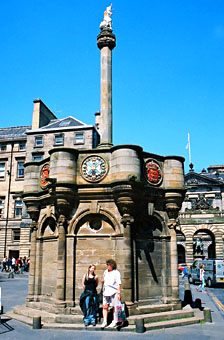
The successor to Coventry's medieval cross is
shown in this detail from the map of Samuel Bradford (1748/49).
Coventry's principal cross stood at the southern end of Cross Cheaping which, as the name indicates was a "shopping street" or marketplace. How long there had been a cross there is uncertain, but in 1423 the city authorities decided to build a new one there, and in July it was ordered that money be handed over to the mayor to finance this and cleaning of the city ditches. The cross appears to have been completed before the end of the year at the hefty cost of £50. When Queen Margaret was welcomed into the city in 1456, the cross was adorned to be part of the spectacle, and was the starting point of a series of pageants presented.
At York plans were underway to construct a new stone cross in the Thursday Market at the same period. In 1421 the widow of John Braithwait gave £13.6s.8d to help pay for this, on condition the money be spent on that project and nothing else.
Further north along Cross Cheaping, at its junction with two other streets, stood Swine Cross, while another of the same name stood at the eastern end of Coventry, just inside Gosford Gate. Bearing in mind their non-central location and their placement on streets leading towards the city centre through some of the main gates, possibly these marked the location of two or four pig pounds ordered set up in 1426, one in each ward, as the principal target for these pounds seems to have been "chapman's wares", i.e. animals (not necessarily just pigs) brought into the town for sale.
|
The Cross Cheaping cross was rebuilt in 1542, thanks to a bequest of £200 from Sir William Hollis, a former mayor of London, who had connections with Coventry; the medieval cross at Abingdon (which has not survived) appears to have been taken as the model. Bradford's map included a more detailed view of the cross - significantly the only city structure he chose to so feature. It was taken down in the eighteenth century, but in the 1970s an effort was made to create a replica based on the instructions in the original commission, and this may be seen in Cuckoo Lane. |

|
The names given market crosses often provide an indication of a market specialization. For instance, at Salisbury the High Cross was also known as the Poultry Cross, the Cheese Cross marked the location of the dairy products market, the Wool Cross the wool market, while Barnewell's Cross stood in the cattle market.
Or the close vicinity of the market cross could be the gathering point for certain types of retailer in a more general market. At London in 1379, for example, the "stations" at the High Cross in Cheap and the Broken Cross on the north side of St. Paul's were rented to the sellers of small wares, who were all women; the terminology is the origins of today's stationery retailers. In mid-fifteenth century Worcester the Grass[market] Cross was designated the point where labourers seeking work were to congregate each day.
At Henley-on-Thames the marketplace was simply part of the High Street (now Hart Street), where it widened slightly to divide on either side of the market cross and fork off into two separate roads. The cross was considered to mark the town centre. In 1441 it was necessary to pass a by-law to prohibit butchers from slaughtering animals within a certain proximity to the cross, as this would of course have posed a nuisance to others buying and selling around the cross.
By 1437 Henley officials, called cross-wardens, were collecting a fee from outsiders stationed by the cross to sell their wares, with the proceeds put towards repairs of the structure; in 1493 a similar collection was made from all those retailing under the roof. By the latter date the cross was explicitly a roofed structure and it seems to have so before 1437, for in 1422 shingles were purchased for the cross and a bell was made at communal expense to be hung up at the cross, a task requiring the services of a carpenter and a long ladder; its purpose was probably to announce the time when market trading could begin and to summon residents (notably the councillors) to assembly meetings at the guildhall, which was close at hand.

A bellman (town crier) reads out
a public announcement from
the steps of a market cross
Drawing by J.C.B. Knight
A cross stood in the swine market at Nottingham, which was held in the area north from what is now Carlton Street; in the fifteenth century part of it was known as Swine Green. This cross was named the Headless Cross, a name used throughout the fourteenth century; it was perhaps the same as the High Cross for which a street north of Carlton is still named. The Weekday Cross, whose name still survives in the Nottingham street at the bottom of which it stood, marked the location of the original marketplace of the town, situated at the point where High Pavement widened out at its west end; post-medieval illustrations show it as a basic pillar-type cross, with an encircling set of steps.
After Nottingham's Norman constable of the castle established a French settlement beside the original Anglo-Saxon town, in the decade or two following the Conquest, a second larger marketplace was created at their border; there we hear, but not until 1495, of the Malt Cross which marked the location of the corn market; it was originally a pillar-type cross, but was in post-medieval times rebuilt as a roofed structure.
Also in the Saturday Market stood the Hen Cross, heard of in 1416; it stood at a junction of several streets in what was later known as the Poultry, and can be seen on Speed's map of Nottingham (1611). On the northwest side of this cross was held the Women's Market, mentioned as a tithing in 1396, and heard of again in 1435, when suggested that the name was no longer widely used, although in fact it is mentioned in a deed of 1503.
A Cheese Cross (later the Butter Cross) is also mentioned, but not until the sixteenth century; as women were predominant in the retail of dairy products, possibly this was the same as the Hen Cross. There was also the Chesterfield Cross, probably in Chesterfield Street (now gone, but in the vicinity of Collin Street), of which little is known.

The Mercat Cross at Edinburgh
dates from 1885, but is a successor to
one known from mid-14th century evidence.
It is no longer topped by a cross, but by
Scotland's unicorn.
Photo © S. Alsford